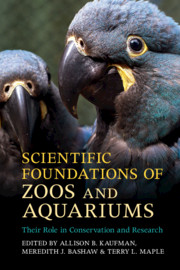Book contents
- Scientific Foundations of Zoos and Aquariums
- Scientific Foundations of Zoos and Aquariums
- Copyright page
- In Memoriam
- Epigraph
- Contents
- Contributors
- Acknowledgments
- Introduction
- Part I Programs and Initiatives
- Part II Captive Care and Management
- 7 Lear’s Macaw (Anodorhynchus leari) Ex Situ Breeding Program at São Paulo Zoo
- 8 Measuring Welfare through Behavioral Observation and Adjusting It with Dynamic Environments
- 9 Empowering Zoo Animals
- 10 Transforming the Nutrition of Zoo Primates (or How We Became Known as Loris Man and That Evil Banana Woman)
- 11 Tough Questions, Complex Answers
- Part III Saving Species
- Part IV Basic Research
- Conclusion
- Appendix
- Index
- References
7 - Lear’s Macaw (Anodorhynchus leari) Ex Situ Breeding Program at São Paulo Zoo
from Part II - Captive Care and Management
Published online by Cambridge University Press: 21 December 2018
- Scientific Foundations of Zoos and Aquariums
- Scientific Foundations of Zoos and Aquariums
- Copyright page
- In Memoriam
- Epigraph
- Contents
- Contributors
- Acknowledgments
- Introduction
- Part I Programs and Initiatives
- Part II Captive Care and Management
- 7 Lear’s Macaw (Anodorhynchus leari) Ex Situ Breeding Program at São Paulo Zoo
- 8 Measuring Welfare through Behavioral Observation and Adjusting It with Dynamic Environments
- 9 Empowering Zoo Animals
- 10 Transforming the Nutrition of Zoo Primates (or How We Became Known as Loris Man and That Evil Banana Woman)
- 11 Tough Questions, Complex Answers
- Part III Saving Species
- Part IV Basic Research
- Conclusion
- Appendix
- Index
- References
Summary
- Type
- Chapter
- Information
- Scientific Foundations of Zoos and AquariumsTheir Role in Conservation and Research, pp. 191 - 211Publisher: Cambridge University PressPrint publication year: 2019
References
- 1
- Cited by

